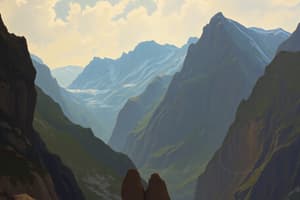Podcast
Questions and Answers
What is the theory of plate tectonics?
What is the theory of plate tectonics?
Plate tectonic theory states that the earth's lithosphere, or outer shell, is divided into several huge plates that glide on the slowly moving rock of Earth's surface.
How does Earth's structure affect plate tectonics?
How does Earth's structure affect plate tectonics?
The tectonic plates glide over Earth's mantle, which is constantly circulating due to heat.
Is it true that Earth is made of solid rock and you can drill straight down to the core?
Is it true that Earth is made of solid rock and you can drill straight down to the core?
False (B)
What evidence supports the theory of plate tectonics?
What evidence supports the theory of plate tectonics?
Does the lava in volcanoes come straight from Earth's core?
Does the lava in volcanoes come straight from Earth's core?
What is an earthquake?
What is an earthquake?
What is a theory?
What is a theory?
What is the lithosphere?
What is the lithosphere?
What is the mantle?
What is the mantle?
What is the crust?
What is the crust?
What is a continent?
What is a continent?
What is magma?
What is magma?
What is lava?
What is lava?
What is the Plate Tectonics Theory?
What is the Plate Tectonics Theory?
What does structure refer to in this context?
What does structure refer to in this context?
What is a tectonic plate?
What is a tectonic plate?
What is the asthenosphere?
What is the asthenosphere?
What is convection?
What is convection?
What is an ocean basin?
What is an ocean basin?
What is a fault?
What is a fault?
What is continental crust?
What is continental crust?
What is oceanic crust?
What is oceanic crust?
Flashcards are hidden until you start studying
Study Notes
Theory of Plate Tectonics
- Lithosphere is divided into large, moving tectonic plates on the Earth's surface.
- Movement of these plates causes geological events such as mountain formation, volcanic eruptions, earthquakes, and continental drift.
Earth's Structure and Plate Tectonics
- Tectonic plates glide over the mantle, facilitated by the circulation of material due to heat.
- The partially molten rock in the mantle plays a crucial role in the movement of tectonic plates.
Common Misconceptions
- It is a misconception that Earth is solid rock throughout; extreme conditions prevent drilling to the core.
- Lava does not originate from Earth’s core; rather, it comes from magma chambers primarily found in the crust.
Evidence Supporting Plate Tectonics
- Coastlines of different continents fit together like puzzle pieces, indicating past connections.
- Similar rock types and fossils found on continents separated by oceans support the idea that these landmasses were once joined.
- Seafloor spreading at divergent plate boundaries creates new crust, evidencing active plate movement.
Definitions and Concepts
- Plate Tectonics Theory: Explains the gradual movement of Earth's crust's individual plates.
- Lithosphere: Comprises the crust and outer mantle, primarily made of rock.
- Mantle: A solid rock layer located between the Earth's crust and core.
- Crust: The outermost layer of rock making up the Earth's surface.
Types of Crust
- Continental Crust: Thick and older, mainly granite, forming the continents.
- Oceanic Crust: Thin and younger, mostly basalt, found under oceans, denser than continental crust.
Tectonic Dynamics
- Convection: The transfer of heat caused by the movement of molten material, influencing plate movements.
- Asthenosphere: A layer of soft, solid mobile rock below the lithosphere, facilitating plate movement.
- Tectonic Plates: Massive sections of the Earth's crust that interact along boundaries, causing various geological phenomena.
Geological Phenomena
- Earthquake: Sudden ground shaking resulting from the movement of underground rocks.
- Fault: A crack in the rock where adjacent rocks slide past each other, often associated with tectonic activity.
- Ocean Basin: Depressions in the ocean floor that can vary greatly in depth.
Studying That Suits You
Use AI to generate personalized quizzes and flashcards to suit your learning preferences.




